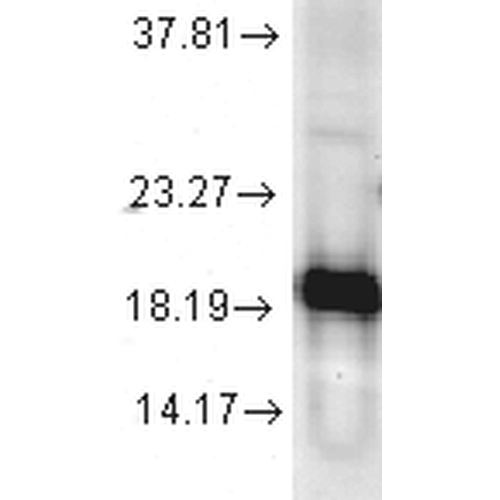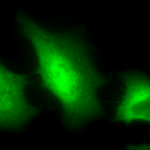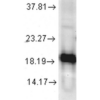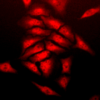Properties
| Storage Buffer | PBS pH7.0, 50% glycerol, 0.09% sodium azide *Storage buffer may change when conjugated |
| Storage Temperature | -20ºC, Conjugated antibodies should be stored according to the product label |
| Shipping Temperature | Blue Ice or 4ºC |
| Purification | Protein A purified |
| Clonality | Polyclonal |
| Specificity | Detects ~23kDa (human) and ~19kDa (other species). |
| Cite This Product | StressMarq Biosciences Cat# SPC-115, RRID: AB_2193769 |
| Certificate of Analysis | 0.5 µg/ml of SPC-115 was sufficient for detection of Cu/Zn SOD in 20 µg of rat brain tissue extract by colorimetric immunoblot analysis using Goat anti-rabbit IgG:AP as the secondary antibody. |
Biological Description
| Alternative Names | Superoxide dismutase1 Antibody, ALS1 Antibody, IPOA Antibody, SOD1 Antibody, SOD2 Antibody, SODC Antibody |
| Research Areas | ALS Disease, Cancer, Cell Signaling, Chaperone Proteins, Neurodegeneration, Neuroscience, Oxidative Stress, Protein Trafficking |
| Cellular Localization | Cytoplasm |
| Accession Number | NP_058746.1 |
| Gene ID | 24786 |
| Swiss Prot | P07632 |
| Scientific Background | Superoxide dismutase (SOD) is an endogenously produced intracellular enzyme present in almost every cell in the body (3). It works by catalyzing the dismutation of the superoxide radical O2ˉ to O2 and H2O2, which are then metabolized to H2O and O2 by catalase and glutathione peroxidase (2,5). In general, SODs play a major role in antioxidant defense mechanisms (4). There are two main types of SOD in mammalian cells. One form (SOD1) contains Cu and Zn ions as a homodimer and exists in the cytoplasm. The two subunits of 16 kDa each are linked by two cysteines forming an intra-subunit disulphide bridge (3). The second form (SOD2) is a manganese containing enzyme and resides in the mitochondrial matrix. It is a homotetramer of 80 kDa. The third form (SOD3 or EC-SOD) is like SOD1 in that it contains Cu and Zn ions, however it is distinct in that it is a homotetramer, with a mass of 30 kDA and it exists only in the extra-cellular space (7). SOD3 can also be distinguished by its heparin-binding capacity (1). |
| References |
1. Adachi T., et al. (1992). Clin. Chim. Acta. 212: 89-102. 2. Barrister J.V., et al. (1987). Crit. Rev. Biochem. 22:111-180. 3. Furukawa Y., O'Halloran T. (2006). Antioxidants & Redo Signaling. Vol 8, No 5,6. 4. Gao B., et al. (2003). Am J Physiol Lung Cell Mol Physiol 284: L917-L925. 5. Hassan H.M. (1988). Free Radical Biol. Med. 5: 377-385. 6. Kurobe N., et al. (1990) Biomedical Research. 11: 187-194 7. Wispe J.R., et al. (1989) BBA. 994: 30-36. 8. Xiao-Hong Liu., et al. (1993) Brain Research. 625: 29-37. |
Product Images

Immunocytochemistry/Immunofluorescence analysis using Rabbit Anti-SOD (Cu/Zn) Polyclonal Antibody (SPC-115). Tissue: Cervical cancer cell line (HeLa). Species: Human. Fixation: 2% Formaldehyde for 20 min at RT. Primary Antibody: Rabbit Anti-SOD (Cu/Zn) Polyclonal Antibody (SPC-115) at 1:120 for 12 hours at 4°C. Secondary Antibody: FITC Goat Anti-Rabbit (green) at 1:200 for 2 hours at RT. Counterstain: DAPI (blue) nuclear stain at 1:40000 for 2 hours at RT. Localization: Cytoplasm. Nucleus. Magnification: 100x. (A) DAPI (blue) nuclear stain. (B) Anti-SOD (Cu/Zn) Antibody. (C) Composite.

Western blot analysis of Human Cell line lysates showing detection of SOD1 protein using Rabbit Anti-SOD1 Polyclonal Antibody (SPC-115). Load: 15 µgprotein. Block: 1.5% BSA. Primary Antibody: Rabbit Anti-SOD1 Polyclonal Antibody (SPC-115) at 1:1000 for 2 hours at RT. Secondary Antibody: Donkey Anti-Rabbit IgG: HRP for 1 hour at RT.

Immunocytochemistry/Immunofluorescence analysis using Rabbit Anti-SOD (Cu/Zn) Polyclonal Antibody (SPC-115). Tissue: Cervical cancer cell line (HeLa). Species: Human. Fixation: 2% Formaldehyde for 20 min at RT. Primary Antibody: Rabbit Anti-SOD (Cu/Zn) Polyclonal Antibody (SPC-115) at 1:120 for 12 hours at 4°C. Secondary Antibody: APC Goat Anti-Rabbit (red) at 1:200 for 2 hours at RT. Counterstain: DAPI (blue) nuclear stain at 1:40000 for 2 hours at RT. Localization: Cytoplasm. Nucleus. Magnification: 20x. (A) DAPI (blue) nuclear stain. (B) Anti-SOD (Cu/Zn) Antibody. (C) Composite.
























StressMarq Biosciences :
Based on validation through cited publications.